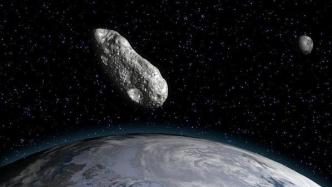
Using the Dark Energy Camera (DECam) mounted on the Víctor M. Blanco 4-meter telescope at the Inter-American Observatory in Monte Tololo, Chile, an international team has discovered three near-Earth asteroids (NEAs) hidden in the sun's glare, one of which It is the largest celestial body with a potential threat to Earth discovered in the past 8 years. A related paper was recently published in the Astronomical Journal.
These elusive near-Earth objects lurk inside the orbits of Earth and Venus, an extremely challenging region to observe as telescopes must contend with the sun's dazzling glare.
Taking advantage of the brief and favorable viewing conditions at dusk, astronomers discovered this group of near-Earth objects. One is a 1.5-kilometer-diameter asteroid called 2022 AP7, whose orbit may one day enter Earth's orbit. Two other asteroids, 2021 LJ4 and 2021 PH27, remain safely inside Earth's orbit. Of particular interest to astronomers and astrophysicists, 2021 PH27 is the closest asteroid known to the sun. As such, it has the largest general relativistic effect of any body in the solar system, and in its orbit, the surface is hot enough to melt lead.
"Our twilight survey is searching for asteroids within the orbits of Earth and Venus," said astronomer Scott S. Sheppard of the Earth and Planetary Laboratory at the Carnegie Institution for Science. "So far, we have found two asteroids about 1 km in diameter. of large near-Earth asteroids, which we call 'planet killers'."
"There are probably only a few similarly sized near-Earth objects left, and the orbits of these undiscovered large asteroids are likely to remain inside the orbits of Earth and Venus for most of their time," Sheppard said. Observations are carried out near strong light, so only 25 asteroids with orbits completely within Earth's orbit have been discovered so far."
Finding asteroids in the inner solar system is a daunting challenge. Astronomers have only two brief 10-minute windows per night to observe the region and have to contend with a bright background caused by the sun's glare. Additionally, these observations are very close to the horizon, meaning astronomers have to look through Earth's thick atmosphere, which can blur and distort observations.
Despite these challenges, the unique observational capabilities enabled DECam to discover these three asteroids. This state-of-the-art instrument is one of the highest performing wide-field CCD imagers in the world, allowing astronomers to capture large swaths of the sky with extreme sensitivity. Astronomers call the faint objects caught "deep" observations. The ability to capture deep and wide fields of view is essential when searching for asteroids within Earth's orbit. DECam was funded by the U.S. Department of Energy (DOE) and was built and tested at DOE's Fermilab.
"We need large areas of sky, because the asteroids in the interior are rare, you need depth images, and the asteroids are dim, and you need to fight the bright sky near the sun, and the distorting effects of the Earth's atmosphere," Sheppard said. "DECam can cover Large areas of the sky, reaching depths beyond the reach of small telescopes, allow us to access deeper and wider skies and probe the interior of the solar system like never before."
In addition to detecting asteroids that could pose a threat to Earth, this research is an important step in understanding the distribution of small objects in the solar system. Asteroids that are farther from the sun than Earth are easiest to detect. Because of this, these more distant asteroids tend to dominate current theoretical models of asteroid populations.
"Our DECam survey is one of the largest and most sensitive searches to date for objects in Earth's orbit and near the orbit of Venus," Sheppard said. "This is a great opportunity to understand what types of objects lurk in the inner solar system."
Related paper information:
https://doi.org/10.3847/1538-3881/ac8cff


